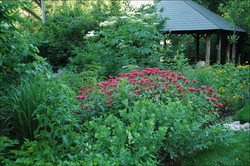 by Shirley Street on Rain Garden Design and Installation On February 26, 15+ Landscape Designers Group members and guests met at Metropolitan Methodist Church in DC for a presentation on the design and installation of rain gardens. Our guest speaker, Shirley Street, certified as an arborist and in natural resources, is also a Master of Landscape Architecture. Over a career of 34 years with the City of Falls Church she contributed to the design and installation of parks, urban streetscapes, and a variety of stormwater management practices, notably rain gardens. Though engineering is an important part of the design of rain gardens, her talk emphasized the role of the landscape designer in creating a multi-seasonal amenity for both aesthetic enjoyment and ecosystem support. Shirley graciously provided several slides and plant recommendations from her presentation. Slides and pictures are available for download at the bottom of the article.  Working with Your Client and Assessing the Site: Flooding, soil erosion, solving water quality problems and gaining BMP (Best Management Practices) credits are common reasons a client may ask you to design a rain garden. In addition, recent interest in keeping stormwater on site and making use of rain water in the garden have contributed to clients’ desire for rain gardens. Initial factors to consider in assessing your client’s site for a rain garden include the slope of the drainage area, the type and perocity of the soil, and the availability of space. Specific conditions for siting a rain garden are that it be at least 10 feet away from a building, a slope of between 1 and 5 percent, location close to drainage to handle overflow in the event of a very heavy rain, at least 2 feet above the high water table, not in a floodplain, and not in standing water, far enough from trees to avoid damage to roots [a local rule of thumb is to be at least 20 feet away from the trunks of trees] , in stable soils, and not over septic systems. Shirley had the following recommendations for conducting the site assessment: 1) that you visit the site in a rain storm to understand the water flows; 2) that you note the plants on the site and their condition; and 3) that you estimate the perocity of the soil by digging a hole, filling it with water and observing how quickly the water is absorbed into the native soil. [Different jurisdictions have different requirements for depth of the hole and how quickly the water is absorbed, so be sure to check with local stormwater agencies.] Calculating the Size and Designing the Rain Garden: Sizing the rain garden is a technical task that involves measuring the size of the impervious surface draining into the rain garden (e.g. a roof or a parking lot), as well as the size of the total drainage area (e.g. sheet flow area across a lawn), calculating the volume of water flowing from these sources in a 1 inch rain, and then sizing the rain garden to hold that volume of water. [Again, different jurisdictions may have different requirements for the number of inches of rain to be captured and the sizing, so be sure to check your local agency.] The diagram below shows the basic design of a rain garden, with a 12 inch stone base, 6 inches of pea gravel, a soil medium of from 24 to 36” depending on the volume of water, 2-3” of mulch or compost, and 6” for ponding. The soil medium is a mixture of sand, compost and top soil [the percentage of each varies by jurisdiction], and Shirley recommends that you request certified soil to ensure that your specifications are met. She also recommends an underflow pipe in the bottom stone layer to carry excess water away and standup pipes to check for any clogging of the drainage pipes. Filter fabric, once commonly used as a base, is no longer recommended as it tends to clog over time and block the absorption of water. Construction of the Rain Garden: During construction be sure that heavy equipment is kept out of the rain garden so that the soil is not compacted and that the edges of the rain garden are stabilized so that they do not erode into the basin.  Plants and Planting the Rain Garden: Rain gardens mimic the natural order of the upland forest floor and of riparian areas, so plants suitable to those ecosystems as well as to location in the piedmont or the coastal plain are appropriate. Before planting, fill the rain garden with water –this is your last chance to evenly grade the soil. Plant to the ponding level and immediately after, stabilize the slopes with compost. If rain water enters the rain garden from a downspout or another concentrated source, the inflow area should be “armoured” with sedges and grasses that can absorb more water than perennials. Woody shrubs also absorb more water than perennials and are useful along edges and in general make the rain garden easier to maintain. In designing, make the rain garden a part of the larger landscape so that it creates a more natural look than would a rain garden by itself. Remember, that the edges of the rain garden and the areas adjacent to it need plants suitable for drier soils. Some recommended plants include: blue wood sedge, Pennsylvania sedge, culver’s root, Echinacea, oxeye sunflower, and golden groundsel, and Virginia sweetspire. Avoid butterfly bush (budlea), fertilizers, and do not plant trees directly in the rain garden. Additional plant recommendations are shown in the attached photos. [Other sources such as North Creek Nursery, have lists of rain garden plants suitable for various conditions.] Maintenance: Prepare a maintenance plan for the client, including instructions to weed, compost as needed, and to water the rain garden in the first two years or until the plants are established. Check the rain garden after the first rain event of more than ½ inch, checking for erosion, the inflow and outflow, breeches along the edges and loss of plants; and over time to replace plants as needed. Thank you Shirley Street! The presentation was very informative, people asked many questions, and the discussion continued after the meeting ended. We extend a big thank you to Shirley for sharing her technical and artistic expertise in the design and construction of rain gardens. Mary Rollefson, Acting LDG Secretary To Download and view the presentation, click below:
0 Comments
|
AuthorsLDG is a non-profit corporation dedicated to the exchange and enhancement of knowledge relevant to the landscape design profession. We are a group of professional designers in the metropolitan Washington, DC area. Membership is meant for students studying and professionals employed in landscape design or associated professions (i.e. arborists, installers, contractors, etc.). Archives
October 2023
CategoriesPast Newsletters can be found in the Members Only Section of the LDG Membership Connection. You must sign in to view these files.
Past Newsletters |
||||||
|
Search for a Landscape Designer in Your Area:
|

 RSS Feed
RSS Feed
